#insect curation
Explore tagged Tumblr posts
Text
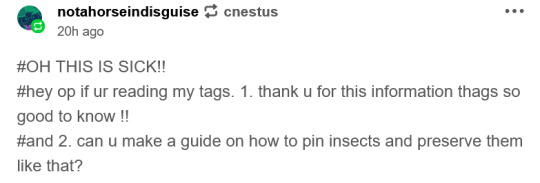
(tagged on this post)
@notahorseindisguise sure, just like a general guide on insect pinning? i can do that.
the nice thing about insects is that once they dry they'll stay exactly as they were positioned indefinitely, so the trick is to pin them when they're still pliable. if you're trying to pin an old, dried insect, you can rehydrate them by putting them in an airtight container with some wet paper towels or sponges for 12-24 hours but probably not much longer than that or you'll risk them molding. i spray some ethanol in there too to be safe. as an example, here's my rehydration box with some bee samples:
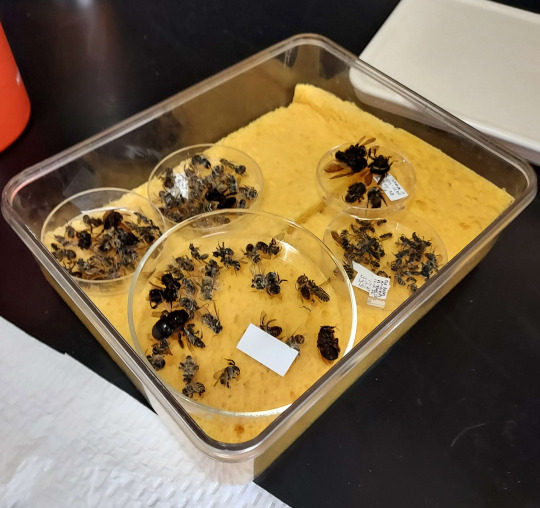
once your insect is ready to curate, put the pin through the thorax to the right of the midline like in my previous post. now, i'm of the philosophy that if you're pinning an insect, you ought to curate it as best as you can so that its death wasn't in vain, so while the specimen is still pliable, secure it to a thick piece of foam and use more pins to position all the legs and antennae into as pleasing an arrangement as possible. here's a botfly i arranged:


besides the aesthetic reasons, this will also help with future identification if that's a possibility since often insects die curled up with important diagnostic features covered up or otherwise hard to see, so at least unfurling the legs a bit and making sure the wing venation is visible on insects where that's important is a good idea.
sometimes you get a longhorned beetle with very long antennae. this is why you want to have a lot of pins on hand:
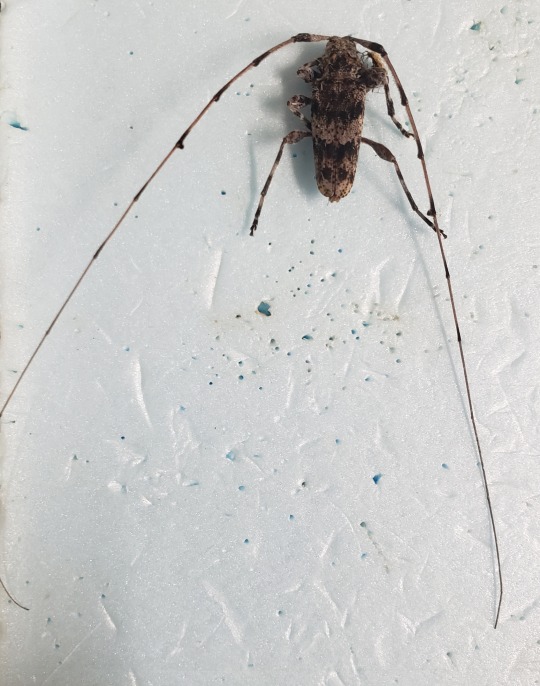
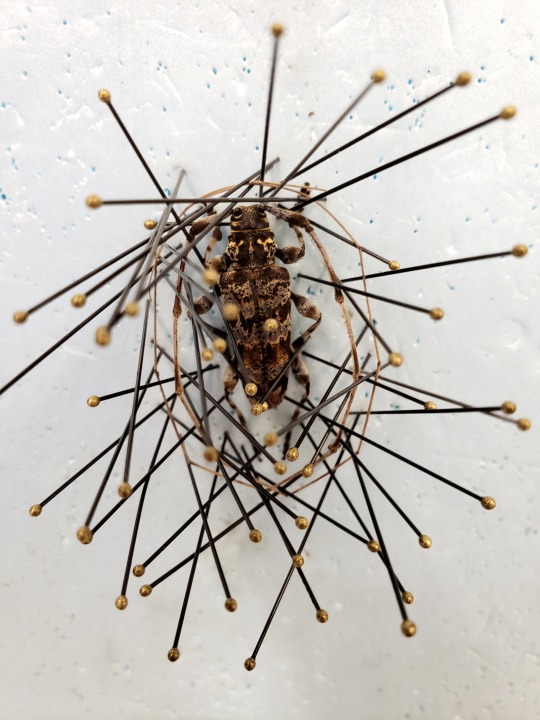
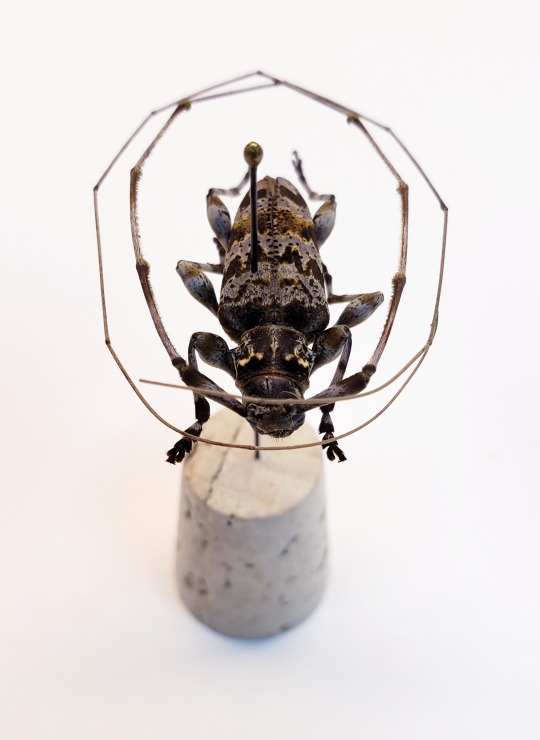

for insects that are too small to pin without risking obliterating their thorax, you'll want to point-mount them, which means gluing them to a small paper triangle and pinning that:


i rarely see people do it but you can sometimes curate point-mounted specimens too if they're the right size, though you'll want to do it under a microscope:
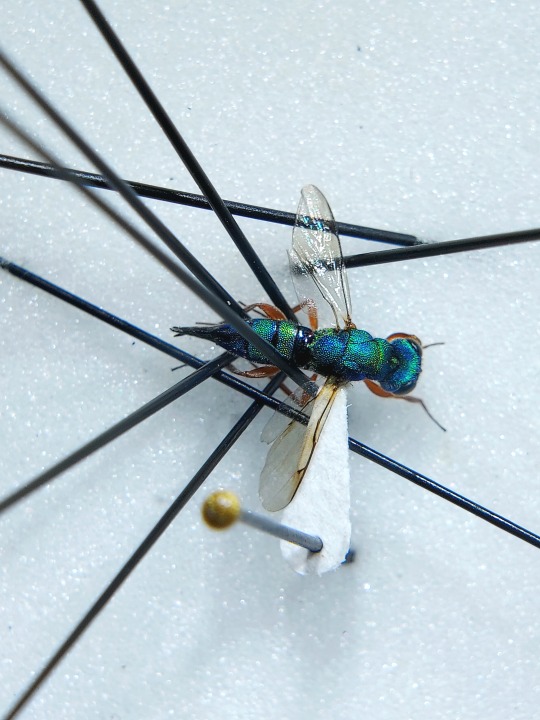
then let your specimens set in a nice dry area for at least a day or two:
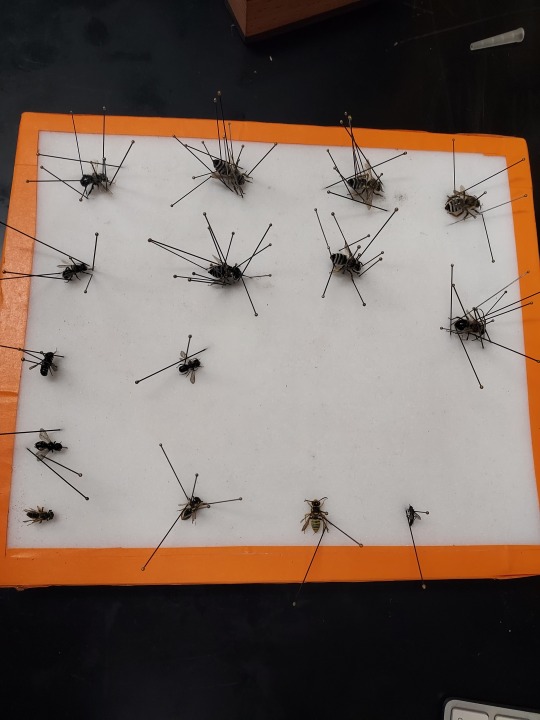

after that you just need to label them (probably for another post. this one is long enough) and they're good to go. once they dry out they're pretty much good to last forever as long as you keep them protected from mold and pests, so the preservation part is handled just by keeping them in an airtight container if possible or at least one with desiccants/pesticides as needed. at the very least try to toss the specimen box in a feezer for a few days at least a couple times a year. otherwise your nicely curated specimens will end up as dermestid shit:


i think that about covers it! it is worth noting that some soft-bodied insects will shrivel horrible when they dry out. small soft insects like silverfish, termites, springtails, most kinds of larvae, etc should go into a vial of alcohol rather than be pinned. same goes for most non-insect arthropods like spiders and centipedes and millipedes which will also fall apart when they dry. also some larger semi-soft insects will need to be stuffed to keep their abdomen from shriveling up, primarily larger grasshoppers, crickets, stenopelmatids, mantids, and stick insects. i made a post about how to do that here.
#insect curation#fuck i always forget if i have a tag for posts like this#i'll add it later if i remember#long post
210 notes
·
View notes
Photo


Absolute unit of a robber fly found by eldoia87 on Reddit (posted with permission)
This beauty is a Beelzebub bee-eater, Mallophora leschenaulti
Found primarily in Texas and Mexico
#animals#curators on tumblr#insects#bugs#fly#diptera#robber fly#bee killer#beelzebub bee eater#one nice bug
9K notes
·
View notes
Text


by insectmyheart
#moth#luna moth#moths#lepidoptera#animals#insects#aesthetic#nature#naturecore#photography#nocturnal#nocturne#curators on tumblr#up
15K notes
·
View notes
Text
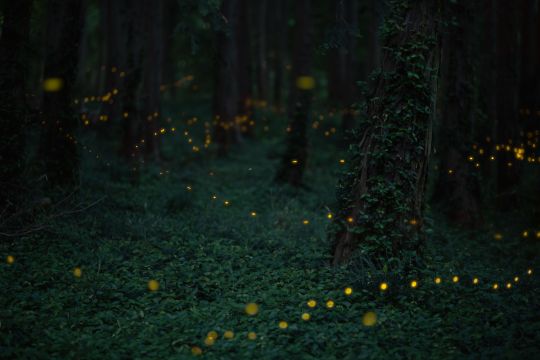
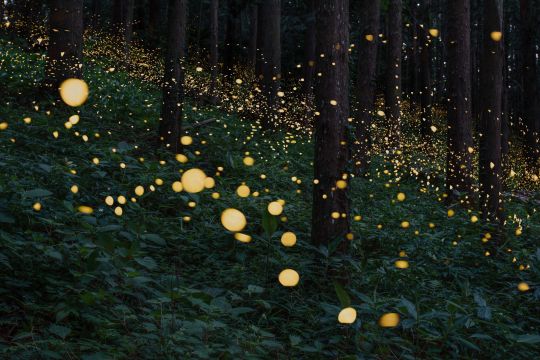
by hitoshirezu
4K notes
·
View notes
Text



Maybeetle
the.lost.woods
462 notes
·
View notes
Text



Male Valley Carpenter Bee (Xylocopa sonorina), which is in my totally unbiased opinion one of the most underrated insects.
#carpenter bee#bee#entomology#naturecore#cottagecore#cute bugs#beautiful bugs#nature#bugs#insects#curators on tumblr#i love bees#nature witch#green witch#witchblr
488 notes
·
View notes
Text

source
#butterflies#insects#wings#butterfly#photography#nature#collage#Asian swallowtail Papilio bianor#Sammamish#curators on tumblr#green#blue#yellow
1K notes
·
View notes
Text

@abigailartsandmore on pinterest
#uploads#pink#paintings#acrylic#canvas#spider#illustrations#spider art#bugs#bug art#insects#arachnids#actually lmao#artsy#arte#artblr#art hoe#art on tumblr#art collective#fuk with art#we all make art#curators on tumblr
7 notes
·
View notes
Text

Pygospila tyres
Pygospila tyres, also known as Spotted Grass Moth or Chequered Snout Moth, is a vibrant moth species from the Crambidae family, calls the rainforests of Southeast Asia its home—from Hong Kong and India to Thailand and Queensland, Australia. First described over 240 years ago by Pieter Cramer in 1780, this moth has roots tracing back to the Coromandel region of India.
ཐི༏ཋྀ
10/07/2024 (06:58 a.m.)
‧₊˚ ☁️⋅♡𓂃 ࣪ .༊·˚
#aes#trip#m#tumblr#entomology#conservation#lepidoptera#protect nature#photography#curators on tumblr#nature#naturecore#rainymood#moth post#insect#biology#zoology#studyblr#study aesthetic#motivation#cottage witch#positivity#original photographers#hiking#female photographers#landscape#explore#colourful#pretty
12 notes
·
View notes
Text



thinking abt the lighting in this scene...... SIGHSS alexa play take me back to eden by sleep token
#MY MY THOSE EYES LIKE FIRE YOU’RE A WINGED INSECT I’M A FUNERAL PYREEEE 🗣️🗣���🗣️#minthara illuminated by torchlight is something else#curating their playlist rn in case anyone is interested.....#catyaps#oc: cassius#cassius x minthara#durgethara#bg3 durge#bg3 dark urge#bg3 the dark urge#bg3 minthara#minthara baenre
9 notes
·
View notes
Text

Assorted Sphinx Moth Collection - Indiana State University
#moths#Pachysphinx modesta#Paonias myops#Smerinthus jamaicensis#Manduca pellenia#Sphinx moth#incredibly obsessed with this box i found in the insect collection at school#really good for my moth tattoo ideas#insect photography#insect cw#insect pinning#(Not my pins Im just the specimen museum curator)#™
63 notes
·
View notes
Text

lottiehampson
12 notes
·
View notes
Photo



Yellow pasha butterfly caterpillar, Herona marathus, Apaturinae (Emperors)
Photographed in China by jiangyou
#animals#curators on tumblr#insects#bugs#caterpillar#larva#butterfly#yellow pasha#emperor#one nice bug
18K notes
·
View notes
Text
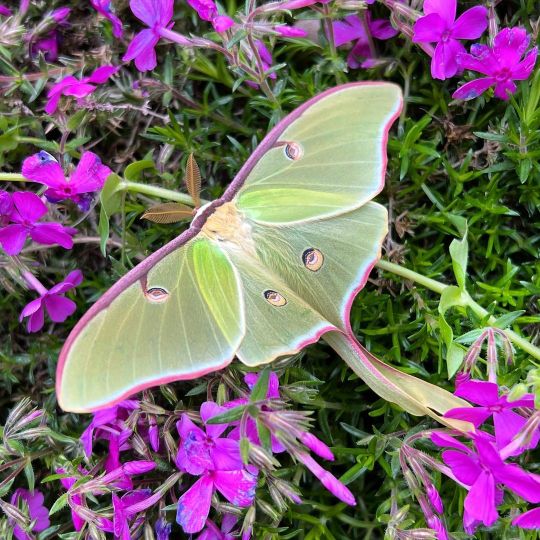
by botanicalmovement
#moth#luna moth#aesthetic#nature#naturecore#cottagecore#fairycore#photography#flowers#insects#animal#gardencore#flowercore#curators on tumblr#up
9K notes
·
View notes
Text
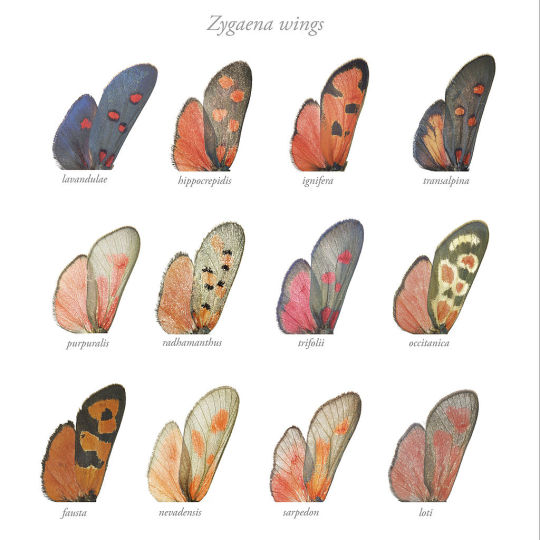
morphology of zygaena - francisco martinez clavel
#bugs!#morphology#zygaena ephialtes#moths#wings#wikipedia#science competition#biology#burnet moth#butterflies#insects#art#curated
16 notes
·
View notes
Text

Glasswing
Alexey Cheplenko
284 notes
·
View notes